|
November 29, 2007
FORESTWATCH CHALLENGES SALVAGE
LOGGING PROJECT IN VENTURA COUNTY
Conservation Group Files
Appeal to Protect Alamo Mountain
and Piru Creek Watershed in the Los Padres National Forest
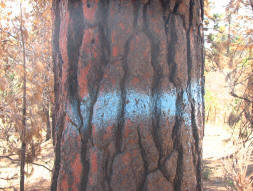 Today,
in an effort to prevent the first commercial timber sale on the
Los Padres National Forest in recent memory, ForestWatch filed a
formal appeal to the top U.S. Forest Service official in
California. The appeal – containing more than one hundred pages
of legal and scientific evidence – formally challenges the
agency’s approval of a 1,000-acre salvage logging project on
Alamo Mountain and Grade Valley, a remote portion of the Los
Padres National Forest in northern Ventura County’s backcountry. Today,
in an effort to prevent the first commercial timber sale on the
Los Padres National Forest in recent memory, ForestWatch filed a
formal appeal to the top U.S. Forest Service official in
California. The appeal – containing more than one hundred pages
of legal and scientific evidence – formally challenges the
agency’s approval of a 1,000-acre salvage logging project on
Alamo Mountain and Grade Valley, a remote portion of the Los
Padres National Forest in northern Ventura County’s backcountry.
The U.S. Forest Service approved
the logging plan in October, allowing private logging companies
to cut an remove all “hazard trees” within 100 to 150 feet on
either side of more than 26 miles of remote dirt roads and
trails. The timber sale would target 1,430 of the most
commercially valuable trees, amounting to 774,000 board feet of
lumber. More than one thousand acres would be affected by the
project.
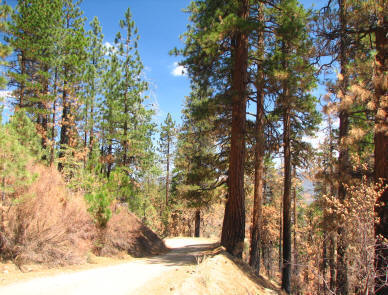
The Alamo Mountain loop
road.
“We appreciate the desire to
provide safe recreation opportunities,” said Jeff Kuyper,
Executive Director of Los Padres ForestWatch, a nonprofit forest
watchdog organization based in Santa Barbara. “However, private
logging companies should not be allowed to cut down trees in
this fragile area that’s just now beginning to show signs of
recovery from last year’s wildfire.”
The commercial logging would occur
in two areas. Most of the trees would be removed from Alamo
Mountain, which, at 7,367 feet in elevation, is one of the
tallest peaks in the Los Padres National Forest. Alamo Mountain
offers commanding views of the adjacent Sespe Wilderness and
across the San Joaquin Valley to the southern Sierras. Some
trees would also be removed from the Grade Valley Road area,
along the boundary of the Sespe Wilderness.
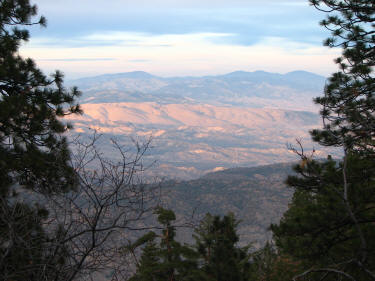
Panoramic views from
atop Alamo Mountain.
More than 150 logging trucks would
be used to haul logs to the nearest lumber mill, located nearly
three hours away in Terra Bella. The trucks would pass along
the edge of the Sespe Wilderness, crossing back and forth over
Piru Creek, which the federal government has nominated for
protection under the Wild & Scenic Rivers Act, the nation’s
strongest river protection law. Much of the logging would occur
in the upper-elevation headwaters of Piru Creek, near places
like Cedar Creek, Frazier Creek, Snowy Creek, and Alamo Creek.
Heavy logging equipment and skid trails – created when large
trees are dragged along the soil – could cause increased
sedimentation into the Piru Creek watershed, particularly since
the ground vegetation that normally would filter out sediment
was burned in the fire.
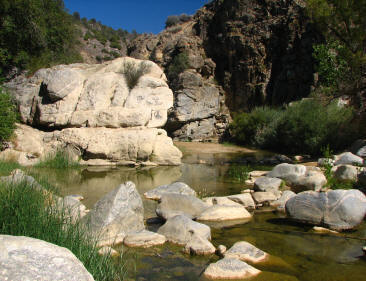
More than 100 logging
trucks will pass by this popular swimming hole on Piru Creek at
the base of Alamo Mountain.
Trees, even dead or dying ones, provide important ecosystem
benefits. They provide habitat for cavity-nesting birds, and
shelter for protected animals like the southern rubber boa and
the yellow-blotched salamander. Their root structure holds
together the soil, preventing erosion and retaining soil
moisture. After eventually falling, dead trees decompose and
provide essential nutrients to support the area’s regrowth.
ForestWatch filed its appeal on November 29, 2007 with Randy
Moore, the Regional Forester for the U.S. Forest Service’s
Pacific Southwest Region, which includes the entire state of
California. The agency received the appeal this week.
The main concerns identified in our appeal include:
-
The
Forest Service approved the Project without first
preparing an Environmental Assessment or Environmental
Impact Statement. Normally, a project of this magnitude
would be analyzed in an Environmental Assessment or
Environmental Impact Statement, as required by the National
Environmental Policy Act. However, the Forest Service
approved this project without preparing those reports,
claiming that the project qualifies as “routine” road
maintenance.
-
Many of the trees marked
for removal survived the fire and do not meet the agency’s
own definition of “hazard trees.” The agency considers
a tree to be a hazard if it has 10% or less visible green
needles, or has 50% of its root system undermined, or has
70% of its tree diameter burned out or decayed. However,
ForestWatch inspected trees targeted for commercial logging
(marked with blue paint), and observed that many of the
marked trees do not meet the agency’s own criteria to
qualify as a “hazard tree.” Instead, they showed significant
new growth, exhibiting abundant green needles as the forest
recovers from the fire.
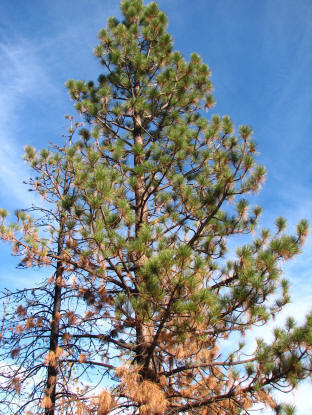
This tree is marked for
removal, despite the presence of many green needles and no decay
or root damage.
-
The Decision failed to
analyze a reasonable alternative – cutting the trees and
leaving them in place to provide wildlife habitat and soil
nutrients. The Forest Service is required to analyze
environmentally superior ways to protect public safety.
During the past several months, we recommended the posting
warning signs to alert forest visitors to potential hazards
in the area, and regularly patrolling the area to ensure
prompt removal of any fallen trees on roads/trails.
If, as a last resort, cutting trees is absolutely necessary,
then we suggested using Forest Service crews (not commercial
logging companies) to fell the most hazardous trees, leaving
them in place for wildlife habitat. The Forest Service
ignored our alternatives.
-
The cost to implement the
commercial salvage sale would exceed revenues. The
logging would require expensive road upgrades before project
implementation (including straightening curves, widening
roads to create safety turnouts, and the construction of
several staging and landing areas), and expensive road
repairs after project implementation.
-
Commercial logging will
occur in ecologically-sensitive riparian areas and on steep
slopes, in violation of the Forest Plan and the National
Forest Management Act. Logging will also occur within a
protected area of Piru Creek, in violation of the Wild &
Scenic Rivers Act and the Forest. While the agency’s
decision creates “Streamside Management Zones” in which
heavy equipment is prohibited, it still allows trees to be
end-lined (dragged by cable) through SMZs to the staging
area. This creates extreme soil disturbance, causing
habitat damage and erosion into streams.
- The
Project will adversely affect the yellow-blotched
salamander, an imperiled animal that is classified as
“sensitive” by the Forest Service and as a “species of
special concern” by the California Department of Fish and
Game.
The ForestWatch appeal requests
that the agency withdraw the project so that it can prepare a
legally and scientifically adequate environmental assessment;
and to make improvements to the project, including prohibiting
logging along streams and on steep slopes, barring logging
within the Piru Creek Wild & Scenic River corridor, and
considering more environmentally preferable alternatives, such
as using federal crews (not private logging companies) to fell
any hazard trees and leave them in place for wildlife and soil
nutrients.
The Forest Service has 45 days to
respond to the ForestWatch appeal. Stay tuned for updates!
|

